Personal Finance Report: Investment, Tax and Financial Planning 2018
VerifiedAdded on 2023/03/29
|11
|1751
|352
Report
AI Summary
This personal finance report provides a detailed analysis of an individual's financial situation, covering aspects such as income computation, tax liability, and investment strategies. It includes an income statement, balance sheet, and a projected budget for the upcoming year. The report assesses the adequacy of current health insurance coverage and provides recommendations for investment portfolio diversification, considering risk preferences and return expectations. The document also touches upon the significance of superannuation and other investment options. Desklib offers a range of study tools and solved assignments to aid students in understanding personal finance concepts and applications.
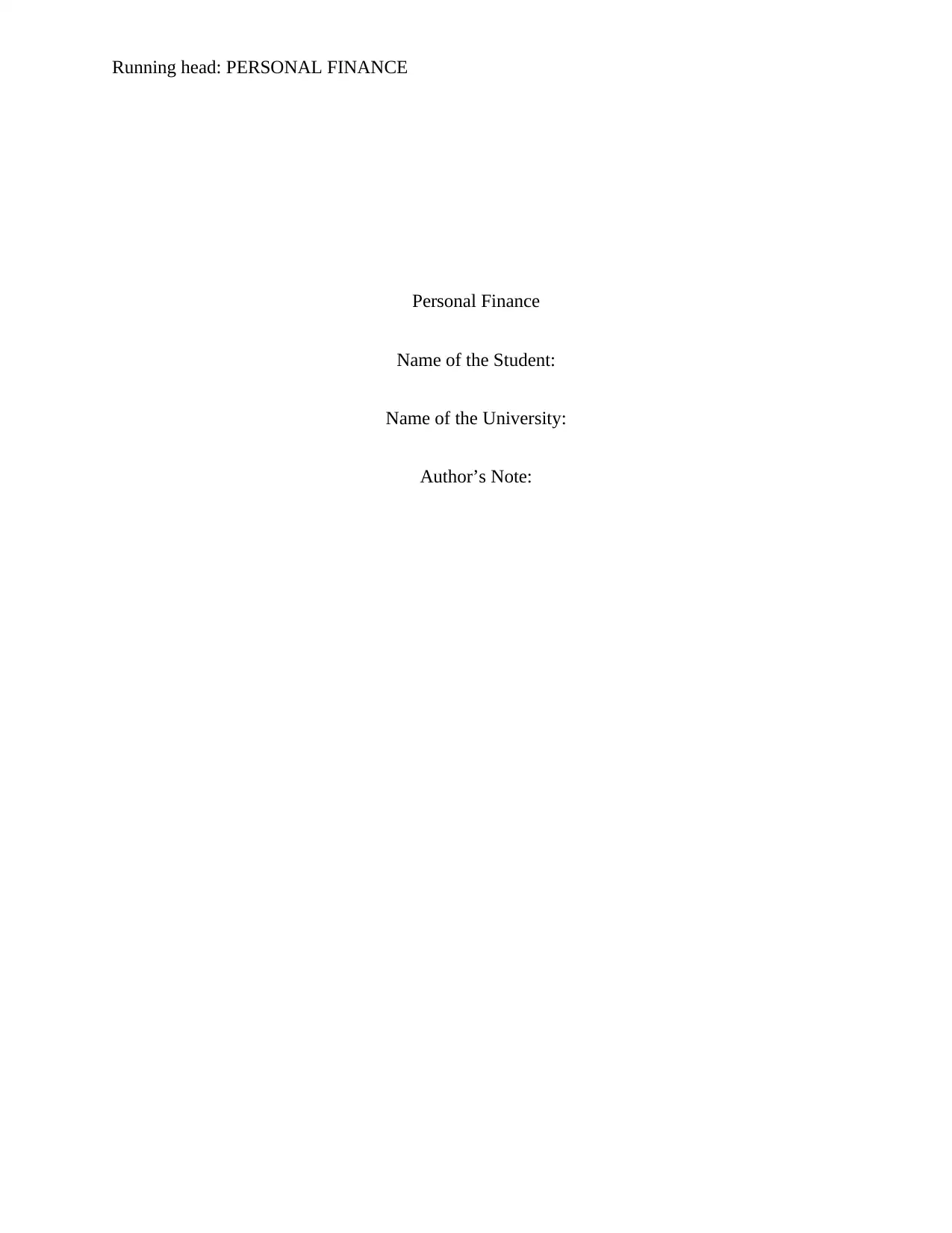
Running head: PERSONAL FINANCE
Personal Finance
Name of the Student:
Name of the University:
Author’s Note:
Personal Finance
Name of the Student:
Name of the University:
Author’s Note:
Paraphrase This Document
Need a fresh take? Get an instant paraphrase of this document with our AI Paraphraser
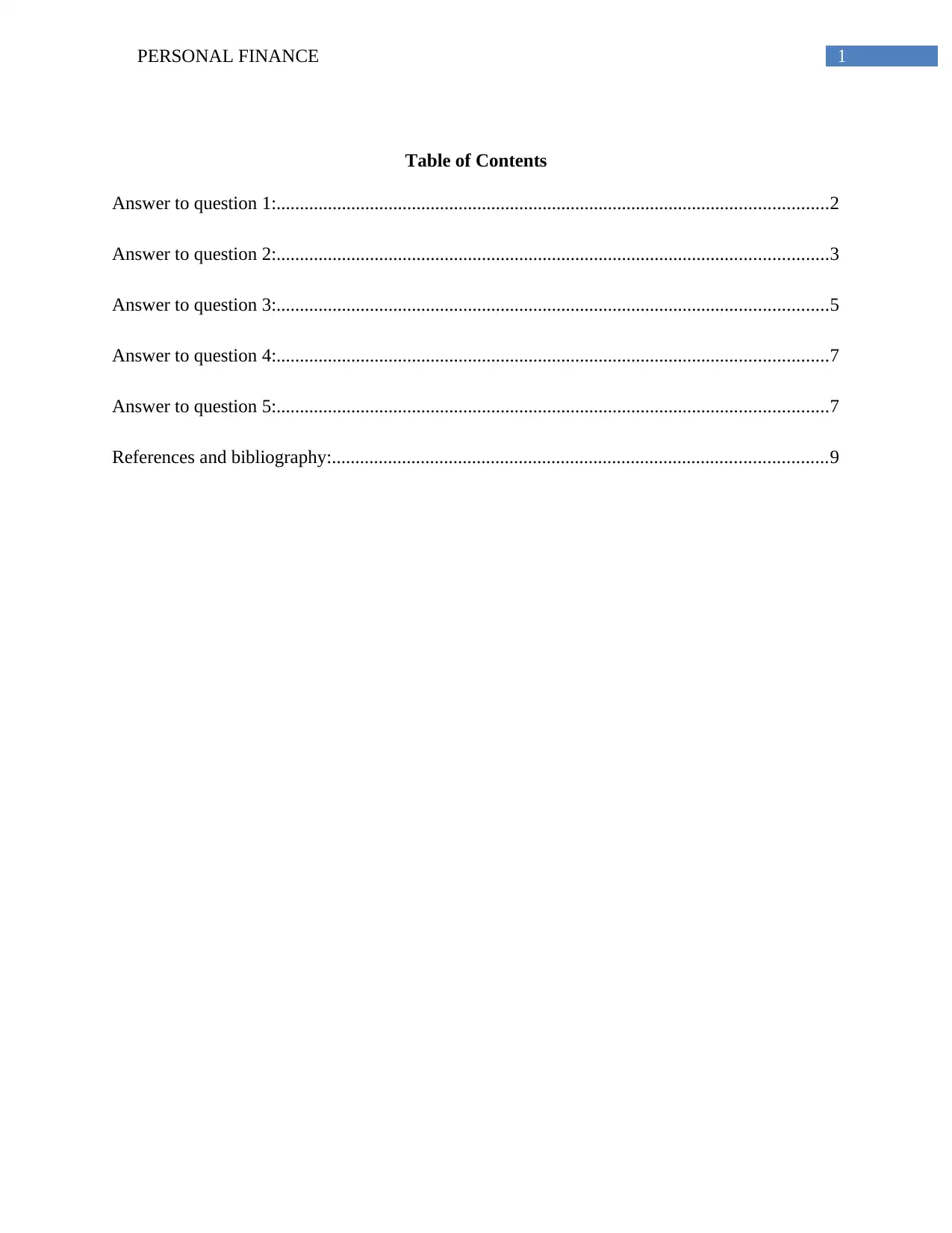
1PERSONAL FINANCE
Table of Contents
Answer to question 1:......................................................................................................................2
Answer to question 2:......................................................................................................................3
Answer to question 3:......................................................................................................................5
Answer to question 4:......................................................................................................................7
Answer to question 5:......................................................................................................................7
References and bibliography:..........................................................................................................9
Table of Contents
Answer to question 1:......................................................................................................................2
Answer to question 2:......................................................................................................................3
Answer to question 3:......................................................................................................................5
Answer to question 4:......................................................................................................................7
Answer to question 5:......................................................................................................................7
References and bibliography:..........................................................................................................9
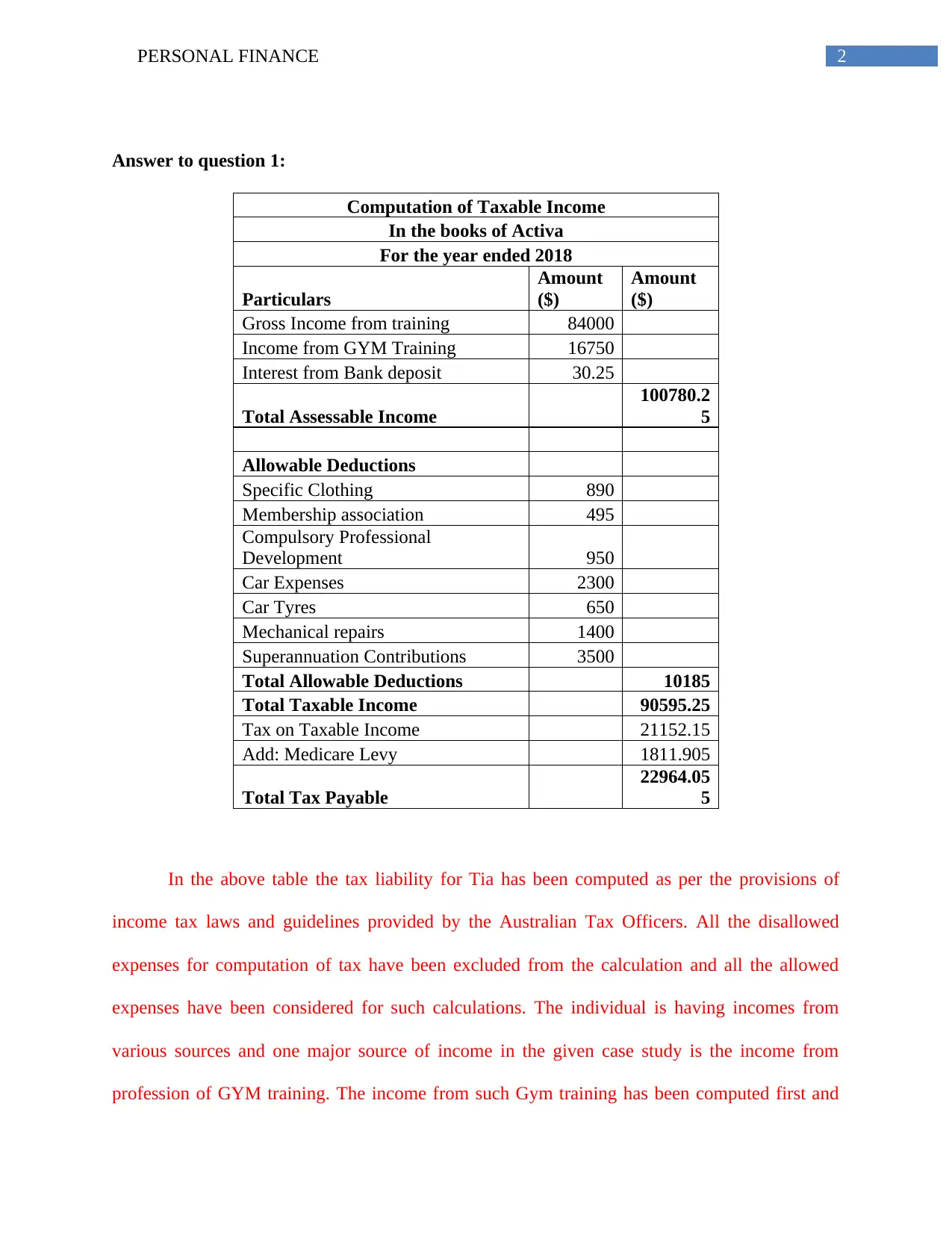
2PERSONAL FINANCE
Answer to question 1:
Computation of Taxable Income
In the books of Activa
For the year ended 2018
Particulars
Amount
($)
Amount
($)
Gross Income from training 84000
Income from GYM Training 16750
Interest from Bank deposit 30.25
Total Assessable Income
100780.2
5
Allowable Deductions
Specific Clothing 890
Membership association 495
Compulsory Professional
Development 950
Car Expenses 2300
Car Tyres 650
Mechanical repairs 1400
Superannuation Contributions 3500
Total Allowable Deductions 10185
Total Taxable Income 90595.25
Tax on Taxable Income 21152.15
Add: Medicare Levy 1811.905
Total Tax Payable
22964.05
5
In the above table the tax liability for Tia has been computed as per the provisions of
income tax laws and guidelines provided by the Australian Tax Officers. All the disallowed
expenses for computation of tax have been excluded from the calculation and all the allowed
expenses have been considered for such calculations. The individual is having incomes from
various sources and one major source of income in the given case study is the income from
profession of GYM training. The income from such Gym training has been computed first and
Answer to question 1:
Computation of Taxable Income
In the books of Activa
For the year ended 2018
Particulars
Amount
($)
Amount
($)
Gross Income from training 84000
Income from GYM Training 16750
Interest from Bank deposit 30.25
Total Assessable Income
100780.2
5
Allowable Deductions
Specific Clothing 890
Membership association 495
Compulsory Professional
Development 950
Car Expenses 2300
Car Tyres 650
Mechanical repairs 1400
Superannuation Contributions 3500
Total Allowable Deductions 10185
Total Taxable Income 90595.25
Tax on Taxable Income 21152.15
Add: Medicare Levy 1811.905
Total Tax Payable
22964.05
5
In the above table the tax liability for Tia has been computed as per the provisions of
income tax laws and guidelines provided by the Australian Tax Officers. All the disallowed
expenses for computation of tax have been excluded from the calculation and all the allowed
expenses have been considered for such calculations. The individual is having incomes from
various sources and one major source of income in the given case study is the income from
profession of GYM training. The income from such Gym training has been computed first and
⊘ This is a preview!⊘
Do you want full access?
Subscribe today to unlock all pages.

Trusted by 1+ million students worldwide
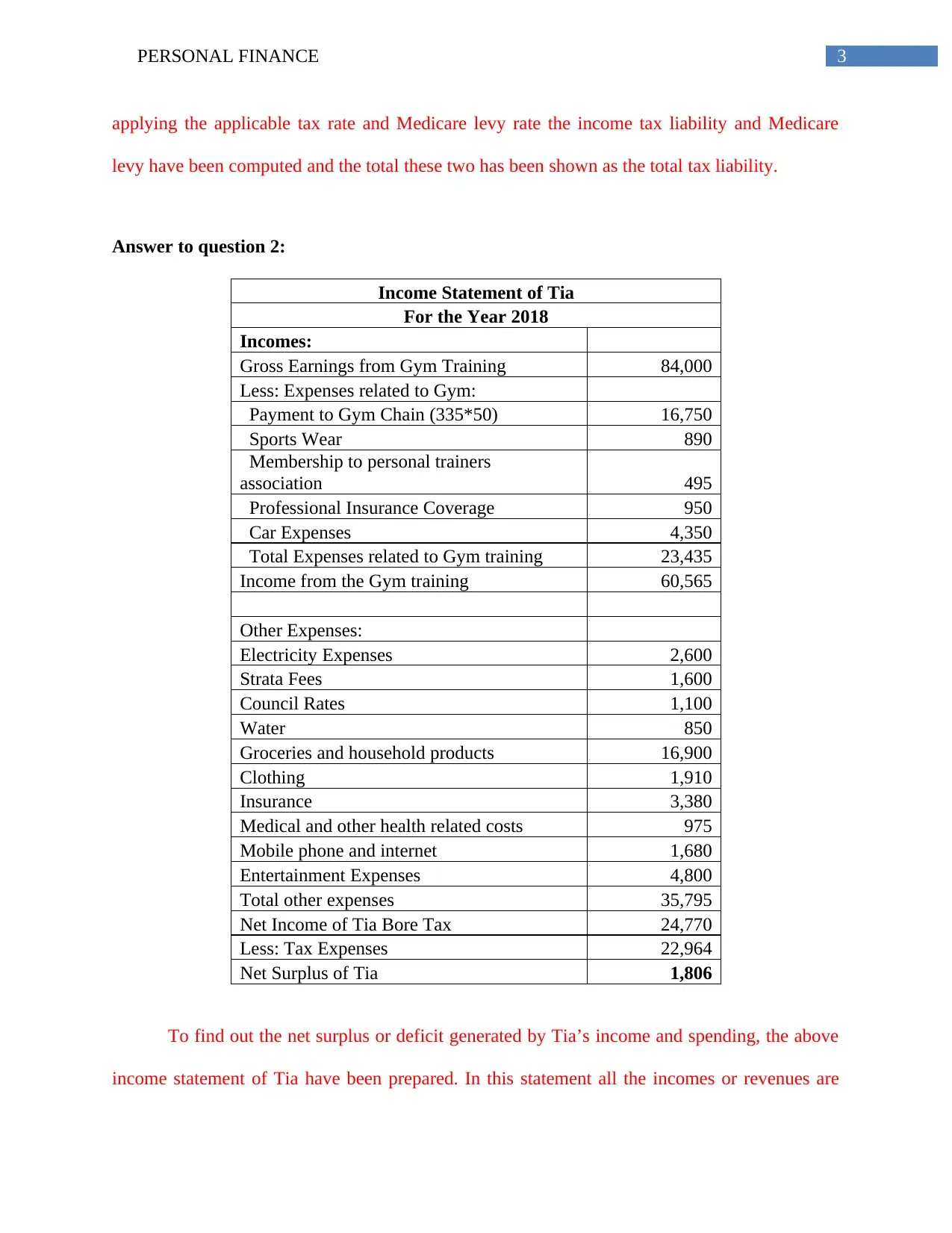
3PERSONAL FINANCE
applying the applicable tax rate and Medicare levy rate the income tax liability and Medicare
levy have been computed and the total these two has been shown as the total tax liability.
Answer to question 2:
Income Statement of Tia
For the Year 2018
Incomes:
Gross Earnings from Gym Training 84,000
Less: Expenses related to Gym:
Payment to Gym Chain (335*50) 16,750
Sports Wear 890
Membership to personal trainers
association 495
Professional Insurance Coverage 950
Car Expenses 4,350
Total Expenses related to Gym training 23,435
Income from the Gym training 60,565
Other Expenses:
Electricity Expenses 2,600
Strata Fees 1,600
Council Rates 1,100
Water 850
Groceries and household products 16,900
Clothing 1,910
Insurance 3,380
Medical and other health related costs 975
Mobile phone and internet 1,680
Entertainment Expenses 4,800
Total other expenses 35,795
Net Income of Tia Bore Tax 24,770
Less: Tax Expenses 22,964
Net Surplus of Tia 1,806
To find out the net surplus or deficit generated by Tia’s income and spending, the above
income statement of Tia have been prepared. In this statement all the incomes or revenues are
applying the applicable tax rate and Medicare levy rate the income tax liability and Medicare
levy have been computed and the total these two has been shown as the total tax liability.
Answer to question 2:
Income Statement of Tia
For the Year 2018
Incomes:
Gross Earnings from Gym Training 84,000
Less: Expenses related to Gym:
Payment to Gym Chain (335*50) 16,750
Sports Wear 890
Membership to personal trainers
association 495
Professional Insurance Coverage 950
Car Expenses 4,350
Total Expenses related to Gym training 23,435
Income from the Gym training 60,565
Other Expenses:
Electricity Expenses 2,600
Strata Fees 1,600
Council Rates 1,100
Water 850
Groceries and household products 16,900
Clothing 1,910
Insurance 3,380
Medical and other health related costs 975
Mobile phone and internet 1,680
Entertainment Expenses 4,800
Total other expenses 35,795
Net Income of Tia Bore Tax 24,770
Less: Tax Expenses 22,964
Net Surplus of Tia 1,806
To find out the net surplus or deficit generated by Tia’s income and spending, the above
income statement of Tia have been prepared. In this statement all the incomes or revenues are
Paraphrase This Document
Need a fresh take? Get an instant paraphrase of this document with our AI Paraphraser
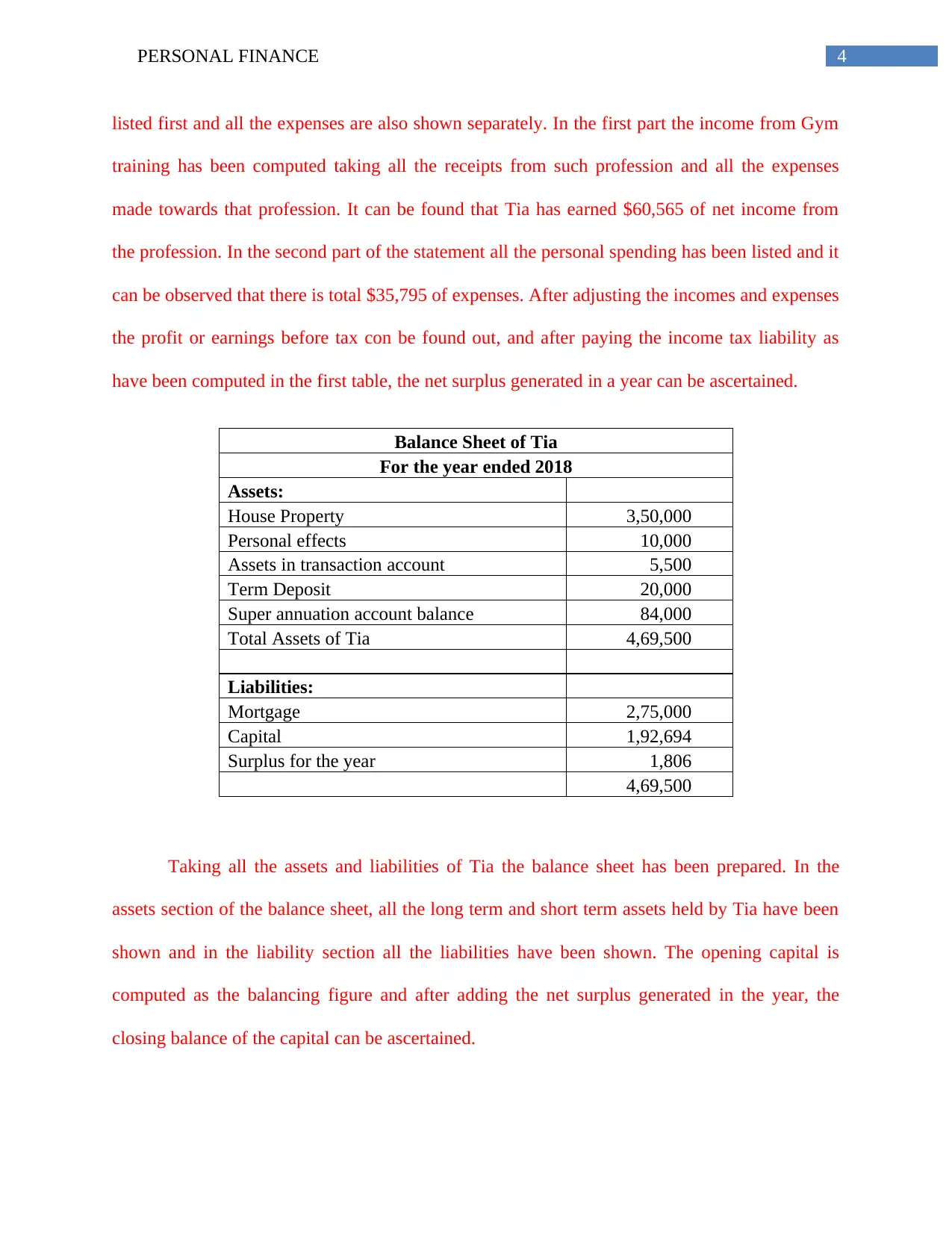
4PERSONAL FINANCE
listed first and all the expenses are also shown separately. In the first part the income from Gym
training has been computed taking all the receipts from such profession and all the expenses
made towards that profession. It can be found that Tia has earned $60,565 of net income from
the profession. In the second part of the statement all the personal spending has been listed and it
can be observed that there is total $35,795 of expenses. After adjusting the incomes and expenses
the profit or earnings before tax con be found out, and after paying the income tax liability as
have been computed in the first table, the net surplus generated in a year can be ascertained.
Balance Sheet of Tia
For the year ended 2018
Assets:
House Property 3,50,000
Personal effects 10,000
Assets in transaction account 5,500
Term Deposit 20,000
Super annuation account balance 84,000
Total Assets of Tia 4,69,500
Liabilities:
Mortgage 2,75,000
Capital 1,92,694
Surplus for the year 1,806
4,69,500
Taking all the assets and liabilities of Tia the balance sheet has been prepared. In the
assets section of the balance sheet, all the long term and short term assets held by Tia have been
shown and in the liability section all the liabilities have been shown. The opening capital is
computed as the balancing figure and after adding the net surplus generated in the year, the
closing balance of the capital can be ascertained.
listed first and all the expenses are also shown separately. In the first part the income from Gym
training has been computed taking all the receipts from such profession and all the expenses
made towards that profession. It can be found that Tia has earned $60,565 of net income from
the profession. In the second part of the statement all the personal spending has been listed and it
can be observed that there is total $35,795 of expenses. After adjusting the incomes and expenses
the profit or earnings before tax con be found out, and after paying the income tax liability as
have been computed in the first table, the net surplus generated in a year can be ascertained.
Balance Sheet of Tia
For the year ended 2018
Assets:
House Property 3,50,000
Personal effects 10,000
Assets in transaction account 5,500
Term Deposit 20,000
Super annuation account balance 84,000
Total Assets of Tia 4,69,500
Liabilities:
Mortgage 2,75,000
Capital 1,92,694
Surplus for the year 1,806
4,69,500
Taking all the assets and liabilities of Tia the balance sheet has been prepared. In the
assets section of the balance sheet, all the long term and short term assets held by Tia have been
shown and in the liability section all the liabilities have been shown. The opening capital is
computed as the balancing figure and after adding the net surplus generated in the year, the
closing balance of the capital can be ascertained.
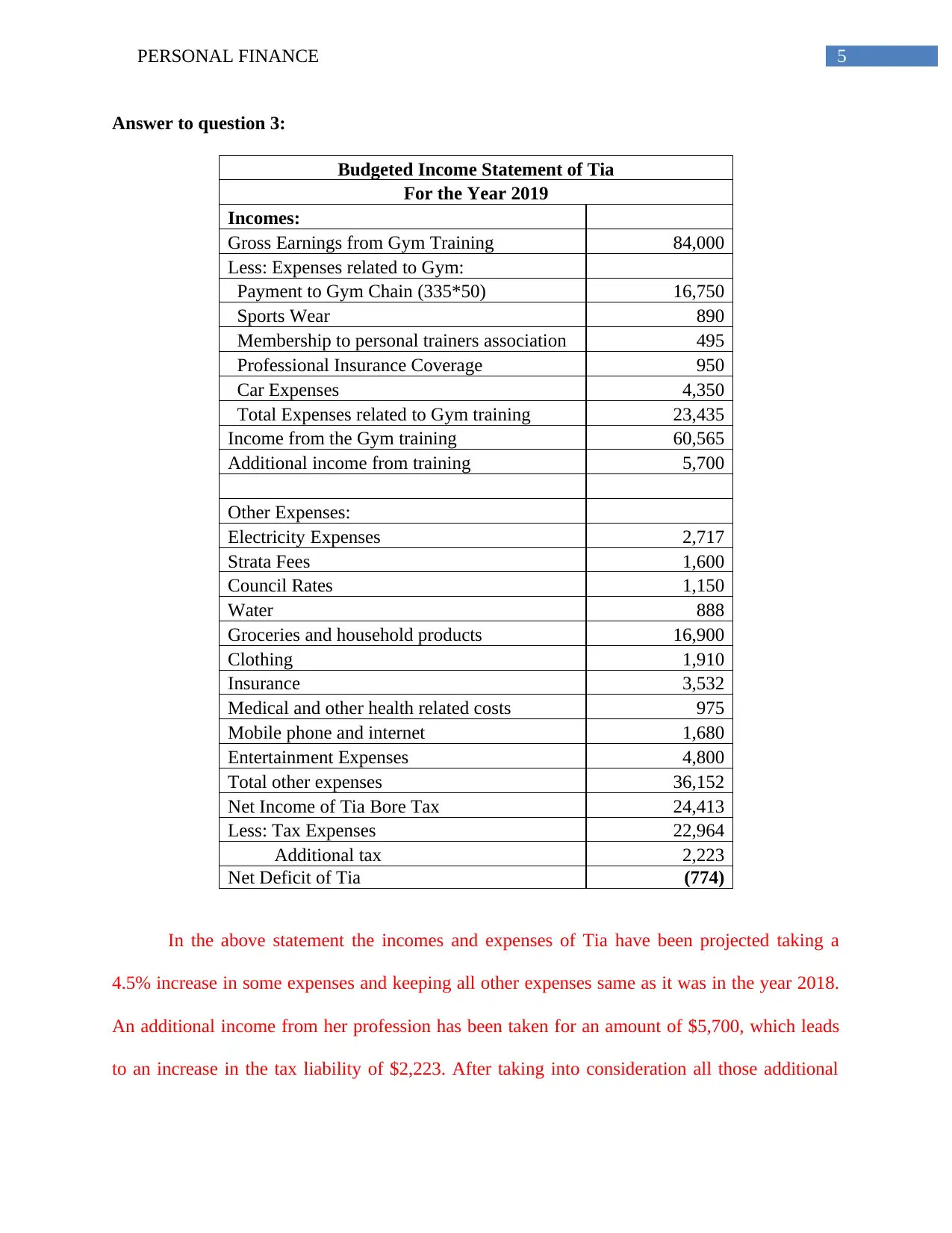
5PERSONAL FINANCE
Answer to question 3:
Budgeted Income Statement of Tia
For the Year 2019
Incomes:
Gross Earnings from Gym Training 84,000
Less: Expenses related to Gym:
Payment to Gym Chain (335*50) 16,750
Sports Wear 890
Membership to personal trainers association 495
Professional Insurance Coverage 950
Car Expenses 4,350
Total Expenses related to Gym training 23,435
Income from the Gym training 60,565
Additional income from training 5,700
Other Expenses:
Electricity Expenses 2,717
Strata Fees 1,600
Council Rates 1,150
Water 888
Groceries and household products 16,900
Clothing 1,910
Insurance 3,532
Medical and other health related costs 975
Mobile phone and internet 1,680
Entertainment Expenses 4,800
Total other expenses 36,152
Net Income of Tia Bore Tax 24,413
Less: Tax Expenses 22,964
Additional tax 2,223
Net Deficit of Tia (774)
In the above statement the incomes and expenses of Tia have been projected taking a
4.5% increase in some expenses and keeping all other expenses same as it was in the year 2018.
An additional income from her profession has been taken for an amount of $5,700, which leads
to an increase in the tax liability of $2,223. After taking into consideration all those additional
Answer to question 3:
Budgeted Income Statement of Tia
For the Year 2019
Incomes:
Gross Earnings from Gym Training 84,000
Less: Expenses related to Gym:
Payment to Gym Chain (335*50) 16,750
Sports Wear 890
Membership to personal trainers association 495
Professional Insurance Coverage 950
Car Expenses 4,350
Total Expenses related to Gym training 23,435
Income from the Gym training 60,565
Additional income from training 5,700
Other Expenses:
Electricity Expenses 2,717
Strata Fees 1,600
Council Rates 1,150
Water 888
Groceries and household products 16,900
Clothing 1,910
Insurance 3,532
Medical and other health related costs 975
Mobile phone and internet 1,680
Entertainment Expenses 4,800
Total other expenses 36,152
Net Income of Tia Bore Tax 24,413
Less: Tax Expenses 22,964
Additional tax 2,223
Net Deficit of Tia (774)
In the above statement the incomes and expenses of Tia have been projected taking a
4.5% increase in some expenses and keeping all other expenses same as it was in the year 2018.
An additional income from her profession has been taken for an amount of $5,700, which leads
to an increase in the tax liability of $2,223. After taking into consideration all those additional
⊘ This is a preview!⊘
Do you want full access?
Subscribe today to unlock all pages.

Trusted by 1+ million students worldwide
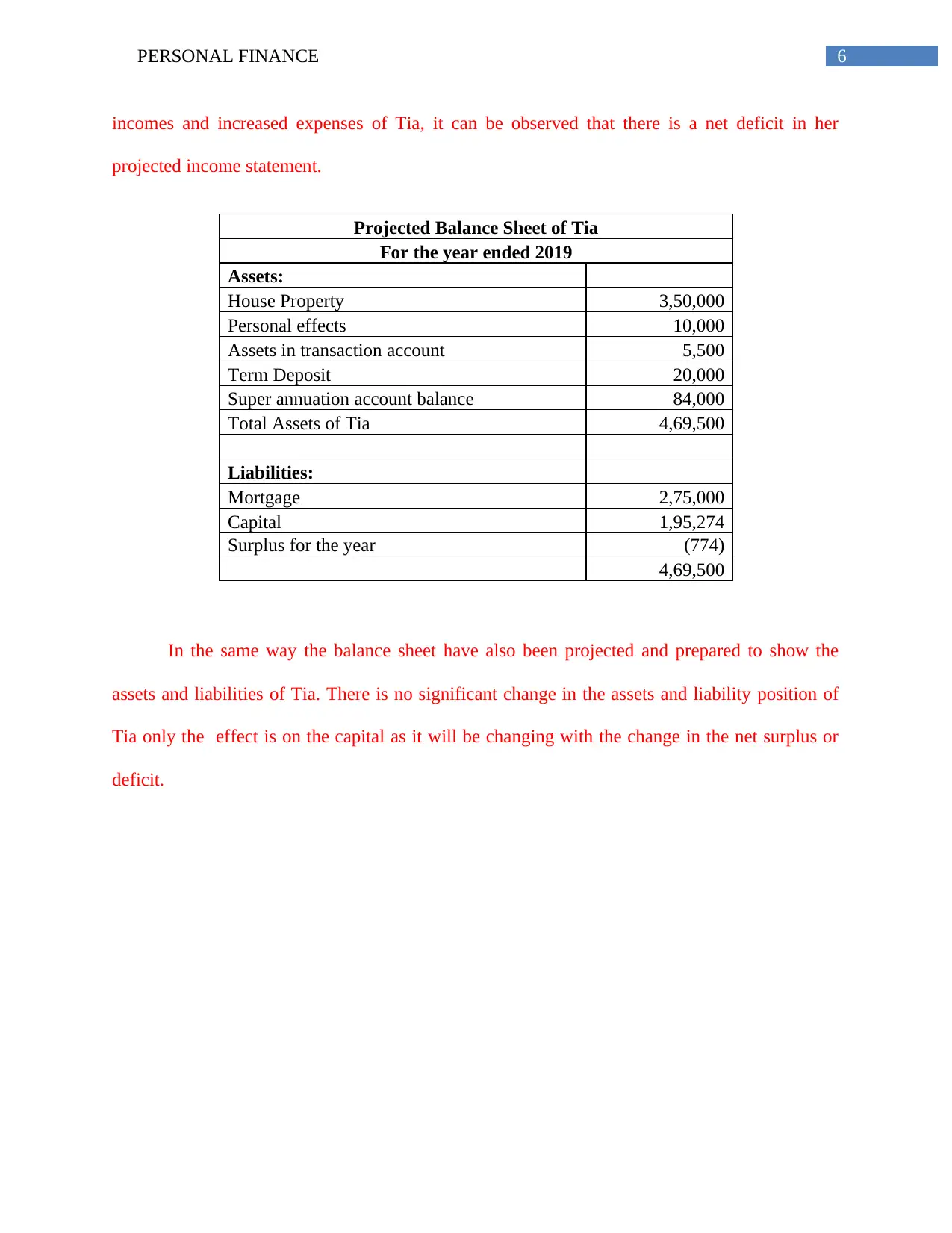
6PERSONAL FINANCE
incomes and increased expenses of Tia, it can be observed that there is a net deficit in her
projected income statement.
Projected Balance Sheet of Tia
For the year ended 2019
Assets:
House Property 3,50,000
Personal effects 10,000
Assets in transaction account 5,500
Term Deposit 20,000
Super annuation account balance 84,000
Total Assets of Tia 4,69,500
Liabilities:
Mortgage 2,75,000
Capital 1,95,274
Surplus for the year (774)
4,69,500
In the same way the balance sheet have also been projected and prepared to show the
assets and liabilities of Tia. There is no significant change in the assets and liability position of
Tia only the effect is on the capital as it will be changing with the change in the net surplus or
deficit.
incomes and increased expenses of Tia, it can be observed that there is a net deficit in her
projected income statement.
Projected Balance Sheet of Tia
For the year ended 2019
Assets:
House Property 3,50,000
Personal effects 10,000
Assets in transaction account 5,500
Term Deposit 20,000
Super annuation account balance 84,000
Total Assets of Tia 4,69,500
Liabilities:
Mortgage 2,75,000
Capital 1,95,274
Surplus for the year (774)
4,69,500
In the same way the balance sheet have also been projected and prepared to show the
assets and liabilities of Tia. There is no significant change in the assets and liability position of
Tia only the effect is on the capital as it will be changing with the change in the net surplus or
deficit.
Paraphrase This Document
Need a fresh take? Get an instant paraphrase of this document with our AI Paraphraser
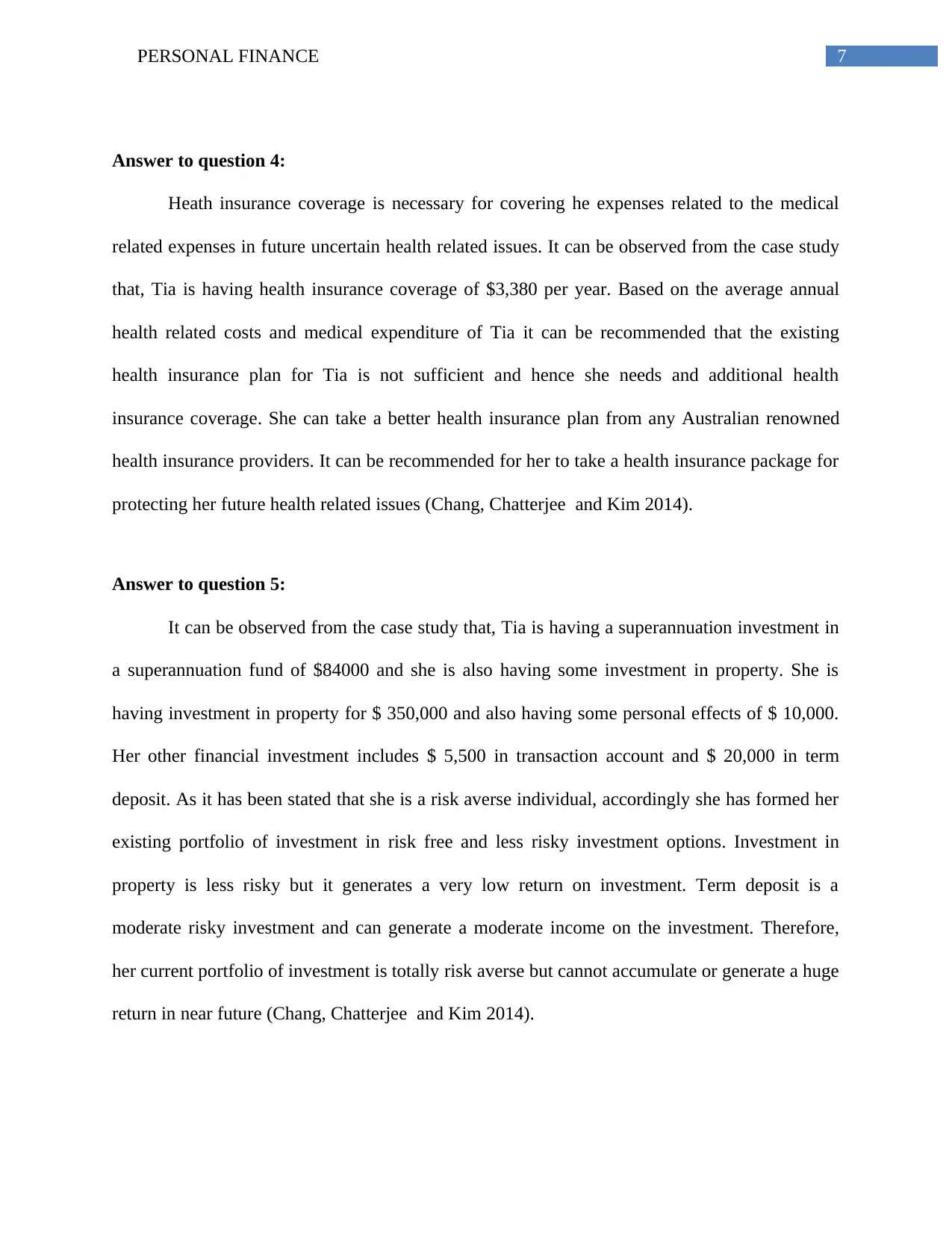
7PERSONAL FINANCE
Answer to question 4:
Heath insurance coverage is necessary for covering he expenses related to the medical
related expenses in future uncertain health related issues. It can be observed from the case study
that, Tia is having health insurance coverage of $3,380 per year. Based on the average annual
health related costs and medical expenditure of Tia it can be recommended that the existing
health insurance plan for Tia is not sufficient and hence she needs and additional health
insurance coverage. She can take a better health insurance plan from any Australian renowned
health insurance providers. It can be recommended for her to take a health insurance package for
protecting her future health related issues (Chang, Chatterjee and Kim 2014).
Answer to question 5:
It can be observed from the case study that, Tia is having a superannuation investment in
a superannuation fund of $84000 and she is also having some investment in property. She is
having investment in property for $ 350,000 and also having some personal effects of $ 10,000.
Her other financial investment includes $ 5,500 in transaction account and $ 20,000 in term
deposit. As it has been stated that she is a risk averse individual, accordingly she has formed her
existing portfolio of investment in risk free and less risky investment options. Investment in
property is less risky but it generates a very low return on investment. Term deposit is a
moderate risky investment and can generate a moderate income on the investment. Therefore,
her current portfolio of investment is totally risk averse but cannot accumulate or generate a huge
return in near future (Chang, Chatterjee and Kim 2014).
Answer to question 4:
Heath insurance coverage is necessary for covering he expenses related to the medical
related expenses in future uncertain health related issues. It can be observed from the case study
that, Tia is having health insurance coverage of $3,380 per year. Based on the average annual
health related costs and medical expenditure of Tia it can be recommended that the existing
health insurance plan for Tia is not sufficient and hence she needs and additional health
insurance coverage. She can take a better health insurance plan from any Australian renowned
health insurance providers. It can be recommended for her to take a health insurance package for
protecting her future health related issues (Chang, Chatterjee and Kim 2014).
Answer to question 5:
It can be observed from the case study that, Tia is having a superannuation investment in
a superannuation fund of $84000 and she is also having some investment in property. She is
having investment in property for $ 350,000 and also having some personal effects of $ 10,000.
Her other financial investment includes $ 5,500 in transaction account and $ 20,000 in term
deposit. As it has been stated that she is a risk averse individual, accordingly she has formed her
existing portfolio of investment in risk free and less risky investment options. Investment in
property is less risky but it generates a very low return on investment. Term deposit is a
moderate risky investment and can generate a moderate income on the investment. Therefore,
her current portfolio of investment is totally risk averse but cannot accumulate or generate a huge
return in near future (Chang, Chatterjee and Kim 2014).
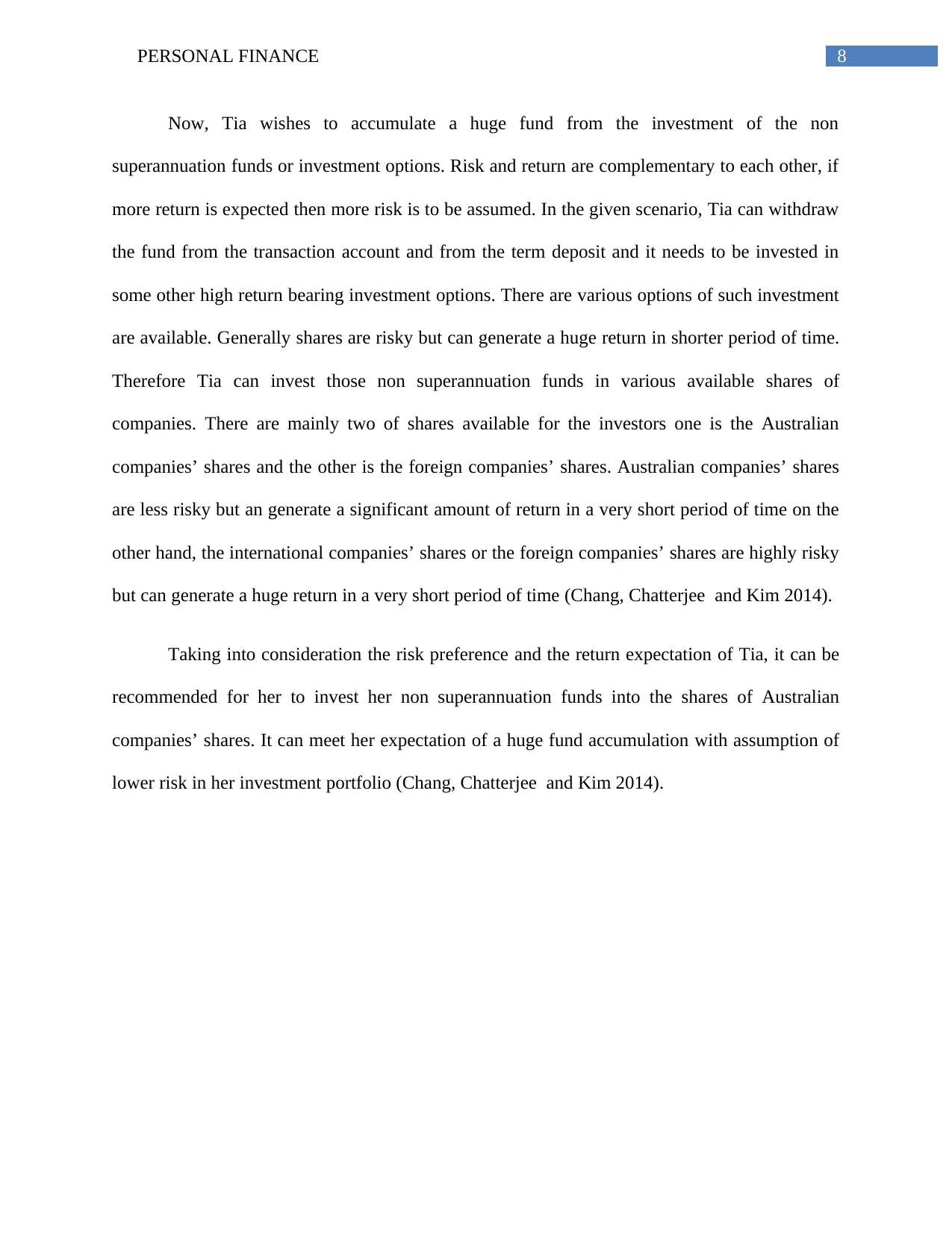
8PERSONAL FINANCE
Now, Tia wishes to accumulate a huge fund from the investment of the non
superannuation funds or investment options. Risk and return are complementary to each other, if
more return is expected then more risk is to be assumed. In the given scenario, Tia can withdraw
the fund from the transaction account and from the term deposit and it needs to be invested in
some other high return bearing investment options. There are various options of such investment
are available. Generally shares are risky but can generate a huge return in shorter period of time.
Therefore Tia can invest those non superannuation funds in various available shares of
companies. There are mainly two of shares available for the investors one is the Australian
companies’ shares and the other is the foreign companies’ shares. Australian companies’ shares
are less risky but an generate a significant amount of return in a very short period of time on the
other hand, the international companies’ shares or the foreign companies’ shares are highly risky
but can generate a huge return in a very short period of time (Chang, Chatterjee and Kim 2014).
Taking into consideration the risk preference and the return expectation of Tia, it can be
recommended for her to invest her non superannuation funds into the shares of Australian
companies’ shares. It can meet her expectation of a huge fund accumulation with assumption of
lower risk in her investment portfolio (Chang, Chatterjee and Kim 2014).
Now, Tia wishes to accumulate a huge fund from the investment of the non
superannuation funds or investment options. Risk and return are complementary to each other, if
more return is expected then more risk is to be assumed. In the given scenario, Tia can withdraw
the fund from the transaction account and from the term deposit and it needs to be invested in
some other high return bearing investment options. There are various options of such investment
are available. Generally shares are risky but can generate a huge return in shorter period of time.
Therefore Tia can invest those non superannuation funds in various available shares of
companies. There are mainly two of shares available for the investors one is the Australian
companies’ shares and the other is the foreign companies’ shares. Australian companies’ shares
are less risky but an generate a significant amount of return in a very short period of time on the
other hand, the international companies’ shares or the foreign companies’ shares are highly risky
but can generate a huge return in a very short period of time (Chang, Chatterjee and Kim 2014).
Taking into consideration the risk preference and the return expectation of Tia, it can be
recommended for her to invest her non superannuation funds into the shares of Australian
companies’ shares. It can meet her expectation of a huge fund accumulation with assumption of
lower risk in her investment portfolio (Chang, Chatterjee and Kim 2014).
⊘ This is a preview!⊘
Do you want full access?
Subscribe today to unlock all pages.

Trusted by 1+ million students worldwide
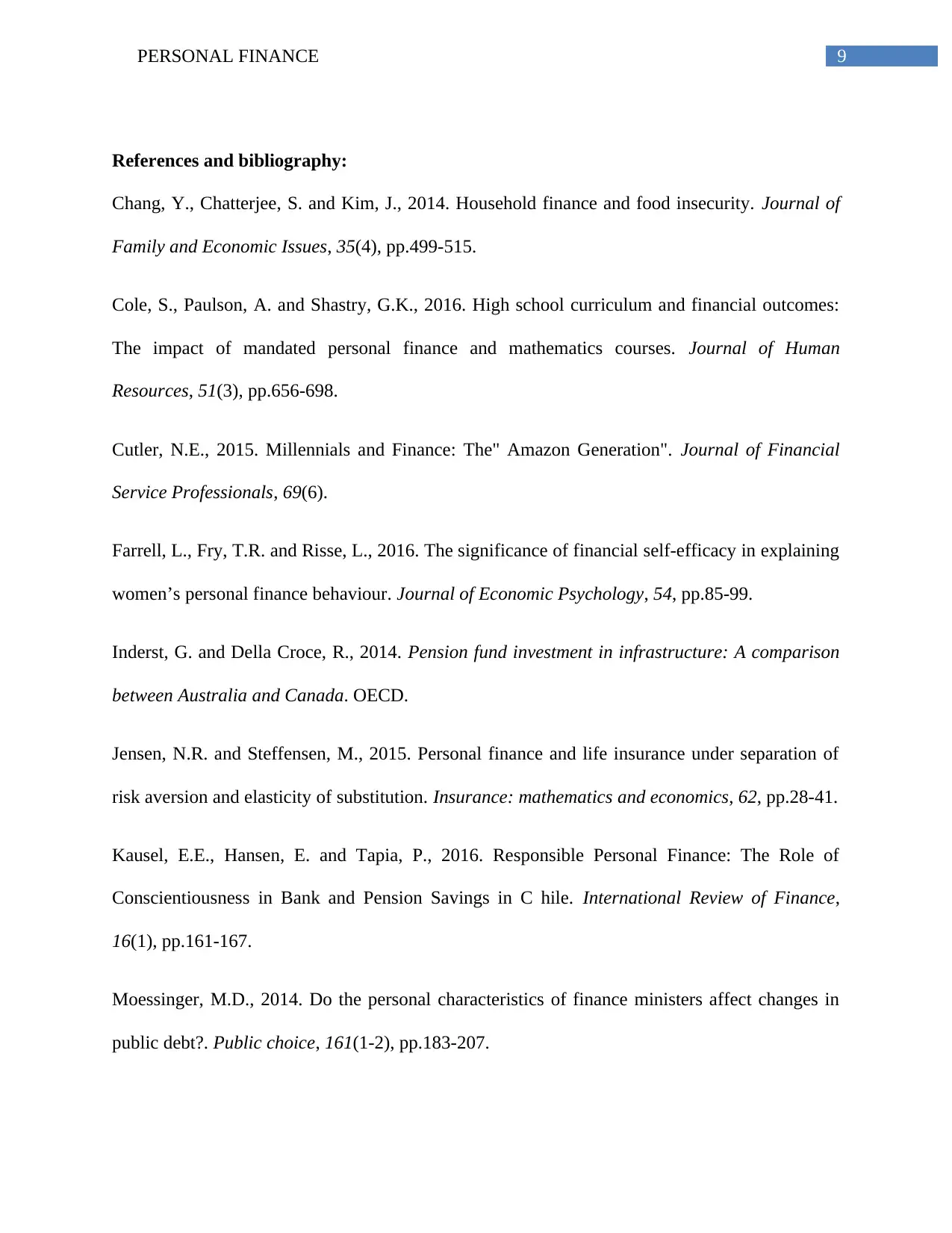
9PERSONAL FINANCE
References and bibliography:
Chang, Y., Chatterjee, S. and Kim, J., 2014. Household finance and food insecurity. Journal of
Family and Economic Issues, 35(4), pp.499-515.
Cole, S., Paulson, A. and Shastry, G.K., 2016. High school curriculum and financial outcomes:
The impact of mandated personal finance and mathematics courses. Journal of Human
Resources, 51(3), pp.656-698.
Cutler, N.E., 2015. Millennials and Finance: The" Amazon Generation". Journal of Financial
Service Professionals, 69(6).
Farrell, L., Fry, T.R. and Risse, L., 2016. The significance of financial self-efficacy in explaining
women’s personal finance behaviour. Journal of Economic Psychology, 54, pp.85-99.
Inderst, G. and Della Croce, R., 2014. Pension fund investment in infrastructure: A comparison
between Australia and Canada. OECD.
Jensen, N.R. and Steffensen, M., 2015. Personal finance and life insurance under separation of
risk aversion and elasticity of substitution. Insurance: mathematics and economics, 62, pp.28-41.
Kausel, E.E., Hansen, E. and Tapia, P., 2016. Responsible Personal Finance: The Role of
Conscientiousness in Bank and Pension Savings in C hile. International Review of Finance,
16(1), pp.161-167.
Moessinger, M.D., 2014. Do the personal characteristics of finance ministers affect changes in
public debt?. Public choice, 161(1-2), pp.183-207.
References and bibliography:
Chang, Y., Chatterjee, S. and Kim, J., 2014. Household finance and food insecurity. Journal of
Family and Economic Issues, 35(4), pp.499-515.
Cole, S., Paulson, A. and Shastry, G.K., 2016. High school curriculum and financial outcomes:
The impact of mandated personal finance and mathematics courses. Journal of Human
Resources, 51(3), pp.656-698.
Cutler, N.E., 2015. Millennials and Finance: The" Amazon Generation". Journal of Financial
Service Professionals, 69(6).
Farrell, L., Fry, T.R. and Risse, L., 2016. The significance of financial self-efficacy in explaining
women’s personal finance behaviour. Journal of Economic Psychology, 54, pp.85-99.
Inderst, G. and Della Croce, R., 2014. Pension fund investment in infrastructure: A comparison
between Australia and Canada. OECD.
Jensen, N.R. and Steffensen, M., 2015. Personal finance and life insurance under separation of
risk aversion and elasticity of substitution. Insurance: mathematics and economics, 62, pp.28-41.
Kausel, E.E., Hansen, E. and Tapia, P., 2016. Responsible Personal Finance: The Role of
Conscientiousness in Bank and Pension Savings in C hile. International Review of Finance,
16(1), pp.161-167.
Moessinger, M.D., 2014. Do the personal characteristics of finance ministers affect changes in
public debt?. Public choice, 161(1-2), pp.183-207.
Paraphrase This Document
Need a fresh take? Get an instant paraphrase of this document with our AI Paraphraser
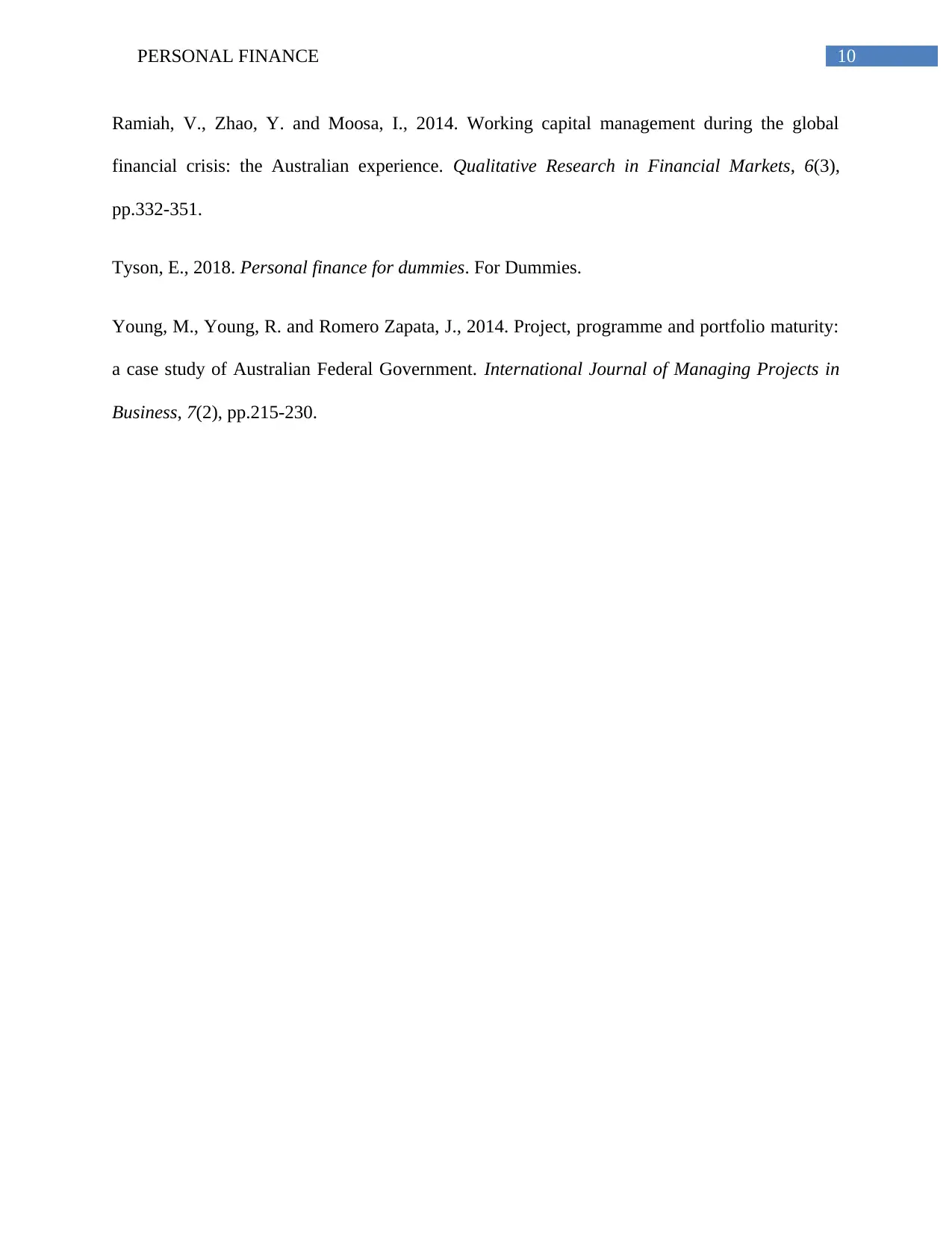
10PERSONAL FINANCE
Ramiah, V., Zhao, Y. and Moosa, I., 2014. Working capital management during the global
financial crisis: the Australian experience. Qualitative Research in Financial Markets, 6(3),
pp.332-351.
Tyson, E., 2018. Personal finance for dummies. For Dummies.
Young, M., Young, R. and Romero Zapata, J., 2014. Project, programme and portfolio maturity:
a case study of Australian Federal Government. International Journal of Managing Projects in
Business, 7(2), pp.215-230.
Ramiah, V., Zhao, Y. and Moosa, I., 2014. Working capital management during the global
financial crisis: the Australian experience. Qualitative Research in Financial Markets, 6(3),
pp.332-351.
Tyson, E., 2018. Personal finance for dummies. For Dummies.
Young, M., Young, R. and Romero Zapata, J., 2014. Project, programme and portfolio maturity:
a case study of Australian Federal Government. International Journal of Managing Projects in
Business, 7(2), pp.215-230.
1 out of 11
Related Documents
Your All-in-One AI-Powered Toolkit for Academic Success.
+13062052269
info@desklib.com
Available 24*7 on WhatsApp / Email
![[object Object]](/_next/static/media/star-bottom.7253800d.svg)
Unlock your academic potential
Copyright © 2020–2025 A2Z Services. All Rights Reserved. Developed and managed by ZUCOL.




